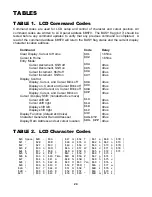
18
ANALOG PORT
PAD0
1 2
PAD8
PAD1
3 4
PAD9
PAD2
5 6
PAD10
PAD3
7 8
PAD11
PAD4
9 10
PAD12
PAD5
11 12
PAD13
PAD6
13 14
PAD14
PAD7
15 16
PAD15
VRL0
17 18
VRH0
VRL1
19 20
VRH1
The
ANALOG
port provides access to the Port AD0 and
Port AD1 Analog-to-Digital input lines.
PAD0 – PAD7
HC12 Port AD0-15 is an input port or A/D
Converter inputs.
VRH / VRL
HC12 A/D Converter Reference Pins. See
A/D Reference Section. To provide an external reference
voltage, R3,4,10 and 32 may need to be removed. See
schematic.
COM1
1
TXD0
2
6
RXD0
3
7
4
8
GND
5
9
The
COM-1
port has a Female DB9 connector that interfaces to
the HC12 internal SCI0 serial port. It uses a simple 2 wire
asynchronous serial interface and is translated to RS232
signaling levels.
COM2
1
2
TXD1
3
4
RXD1
5
6
7
8
GND
9 10
The
COM-2
has a Female DB9 connector that interfaces to the
HC12 internal SCI1 serial port. It uses a simple 2 wire
asynchronous serial interface and is translated to RS232
signaling levels.
JP1
may be used to reverse RS232 RX and TX signals to the
COM2 connector.
NOTE:
1) COM1 and 2 connector Pins 1, 4, and 6 are connected for default handshake standards.
2) COM1 and 2 connector Pins 7 and 8 are connected for default handshake standards.
3) Handshake pins are provided access pads behind the COM connectors for user
application and can be easily isolated from each other on the bottom of the CMD912x
board.
4) SCI0:PS0/RXD0 and SCI1:PS2/RXD1 signals can be isolated from the RS232 transceiver
by turning COM Switch positions 1 and 2 OFF respectfully.
5) SCI0:PS1/TXD0 and SCI1:PS3/TXD1 signals can be isolated from the RS232 transceiver
by removing resistors R10 and R11 respectfully from the bottom of the CMD912x board.










































